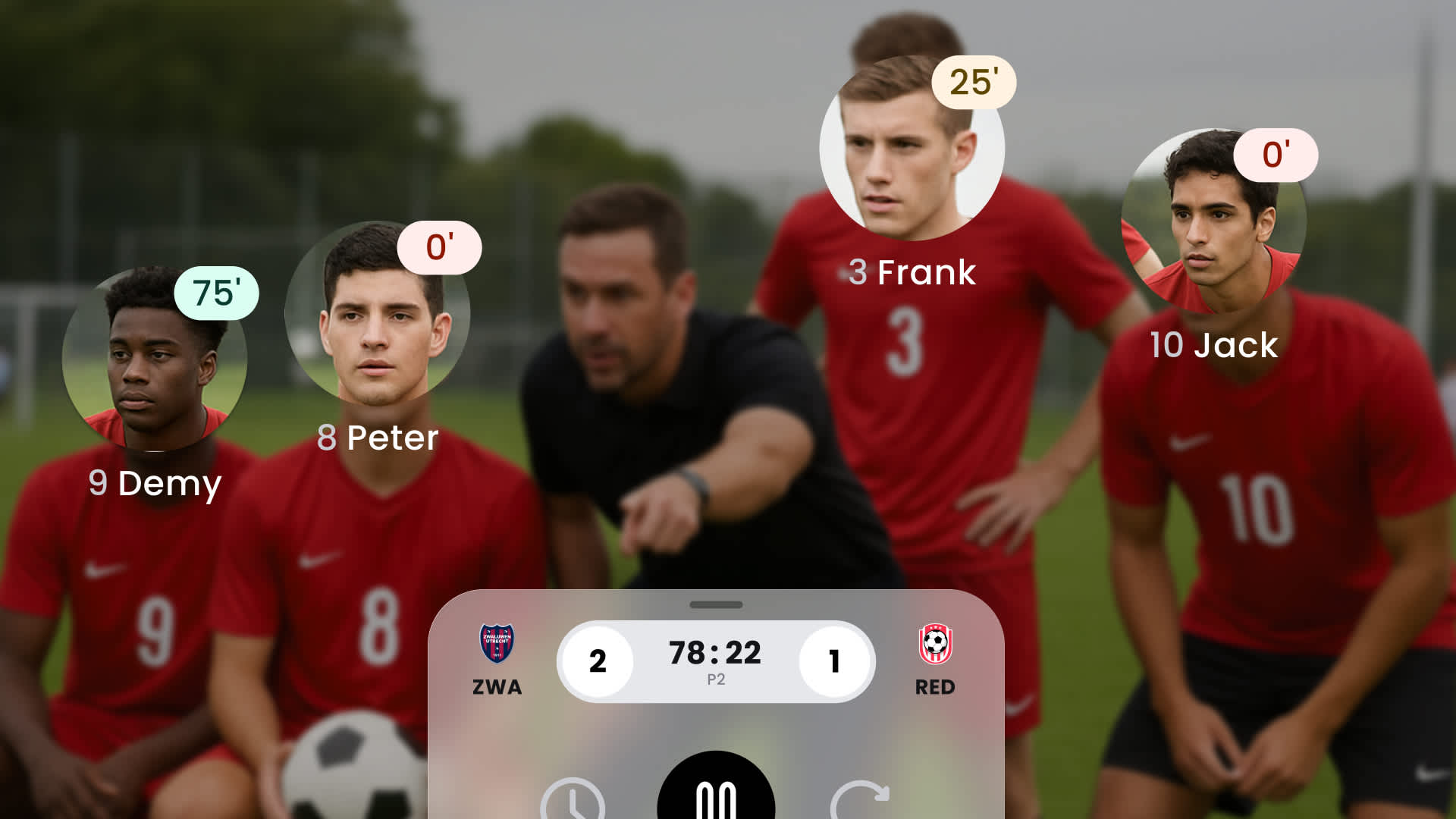5 Time-Saving Tips for Technical Directors in Football Clubs

How technical directors can save 5-10 hours per week using digital tools for player development, performance analysis, and talent identification in youth football academies and clubs.
As a technical director at a football club, your days are packed with player evaluations, performance tracking, tactical planning, and coordinating between coaches, players, and parents. The administrative burden can often overshadow the strategic work that truly develops your club. Here are five practical tips to reclaim your time and focus on what matters most: developing players and winning matches.
1. Centralize Your Player Data in One Football Management System
Technical directors often juggle multiple spreadsheets, paper forms, and different software tools to track player attendance, match statistics, and performance metrics. This fragmented approach wastes hours each week just searching for information and reconciling data across platforms.
How technical directors can implement centralized player tracking:
Start by auditing all the different places you currently store player data (spreadsheets, paper forms, various apps)
Choose a centralized football management platform that covers at least 80% of your data needs
Begin with one team as a pilot program before rolling out club-wide
Train coaches on mobile data entry during a single workshop session
Best football club management systems for technical directors:
Mingle Sport: Offers mobile app for coaches to input data on-the-go, with Homebase web platform for technical directors to access club-wide analytics and player performance tracking
PMA (Player Management Application): Comprehensive player database with youth development tracking
Hudl: Good for video analysis integration alongside performance data in football
Simple start: Even a shared Google Workspace with standardized templates beats scattered Excel files
2. Streamline Cross-Team Performance Comparisons and Football Analytics Reporting
Technical directors in football academies often spend hours manually compiling performance data from different teams to identify trends, compare player development across age groups (U12, U14, U16, U18), and prepare board reports. When each team tracks data differently or in isolated systems, creating these comparative analyses becomes a weekly time sink.
How to implement automated football performance reporting:
Create standardized KPIs that every team must track (e.g., attendance percentage, minutes played, goals per game, assists, pass completion rate)
Set up automated weekly reports that pull data from all youth teams
Build a simple dashboard showing red/yellow/green indicators for each team's key metrics
Schedule monthly data review sessions with coaches to ensure consistent data entry
Football analytics platforms for technical directors:
Mingle Sport Homebase: Provides club-wide analytics with exportable reports and player progression tracking across all youth football teams
Tableau or Power BI: For clubs already using Microsoft/data systems, these can create custom football performance dashboards
Google Data Studio: Free option that works well with Google Sheets for smaller football clubs
TeamStats or Coach Logic: Alternative platforms with cross-team reporting features for football academies
3. Digitize Your Football Talent Identification and Player Pathway Management
Tracking player progression through your club's pathway—from grassroots football to elite academy teams—typically involves maintaining complex spreadsheets, reviewing scattered coach notes, and relying on memory during selection meetings. This fragmented approach makes it easy to overlook talented young players or miss concerning development patterns.
How to implement digital talent ID in youth football:
Define clear, measurable criteria for progression between levels (technical skills, tactical awareness, physical development, mental attributes)
Create player profiles that follow them throughout their youth football journey
Set up quarterly review cycles where data automatically flags players exceeding or falling below benchmarks
Establish a simple traffic light system: green (ready for progression), yellow (monitor closely), red (needs support)
Best talent identification software for football academies:
Mingle Sport: Tracks complete player history including minutes played, match performance ratings, and physical tests (sprint times, stamina, agility) with evaluation tools for all four development pillars
Scout7 or Wyscout: More advanced scouting platforms for elite football academies
Performance Lab: Australian system with strong pathway management features for youth football
DIY approach: Create a Microsoft Access database or Airtable system with linked player records
4. Standardize Player Evaluations Across All Youth Football Teams
Inconsistent evaluation methods across different age groups and teams make it nearly impossible to track player progression effectively in youth football. When each coach uses their own system, comparing players or identifying club-wide development trends becomes a time-consuming nightmare for technical directors.
How to standardize football player assessments:
Develop a simple 1-10 rating system for 4-6 key attributes relevant to each age group (ball control, passing, positioning, work rate, decision making, communication)
Create age-appropriate benchmarks (what "good" looks like at U12 vs U16 in football)
Require monthly evaluations as a non-negotiable for all youth football coaches
Use the same evaluation template whether it's digital or paper-based
Player evaluation systems for football clubs:
Mingle Sport: Built-in player evaluation tools covering technical, tactical, physical and mental skills in football with goal setting features
CoachEye: AI-powered video analysis with standardized evaluation criteria for football
TopSportsLab: Comprehensive testing and evaluation platform for youth athletes
Budget option: Create a standardized Google Form that feeds into a master spreadsheet—takes 30 minutes to set up
5. Make Football Performance Data Work for Multiple Stakeholders
The same performance data you collect often needs to serve multiple audiences: coaches for tactical planning, players for motivation, parents for engagement, and the club for recruitment and retention. Reformatting this information for each audience is a massive time drain for technical directors.
How to maximize football data efficiency:
Design your data collection with the end outputs in mind (player report cards, social media content, board presentations)
Set up automated reports for each audience (weekly tactical reports for coaches, monthly progress reports for parents, quarterly performance reviews for board)
Create templates for common outputs (player development reports, match highlights, season statistics)
Train one person per team to be the "content creator" who transforms match data into shareable formats
Multi-purpose football data platforms:
Mingle Sport: Automatically generates shareable match reports, player statistics for social media, and progression analytics from the same football performance data set
Canva + your data platform: Create templates in Canva that you can quickly populate with football statistics
Mailchimp or similar: Set up automated email campaigns that pull data from your football management system
WordPress plugins: If you have a club website, plugins like SportsPress can display live football stats and generate multiple formats
Conclusion: Transforming Football Club Management Through Technology
Technology should reduce your administrative burden, not add to it. The key is finding tools designed specifically for football clubs that understand the unique challenges technical directors face in youth player development. Start with one tip, implement it fully, then move to the next. Even implementing just two or three of these strategies can free up 5-10 hours per week for the strategic work that actually develops better players and stronger clubs.
By centralizing football data, automating performance reporting, digitizing talent pathways, standardizing player evaluations, and making data serve multiple purposes, technical directors can reclaim their time for what truly matters: developing young football players, supporting coaches, and building winning cultures. The clubs that embrace these efficiencies will have a significant advantage—not just in saved time, but in player development, parent satisfaction, and competitive performance.
Click here to learn more about Mingle for Clubs.





